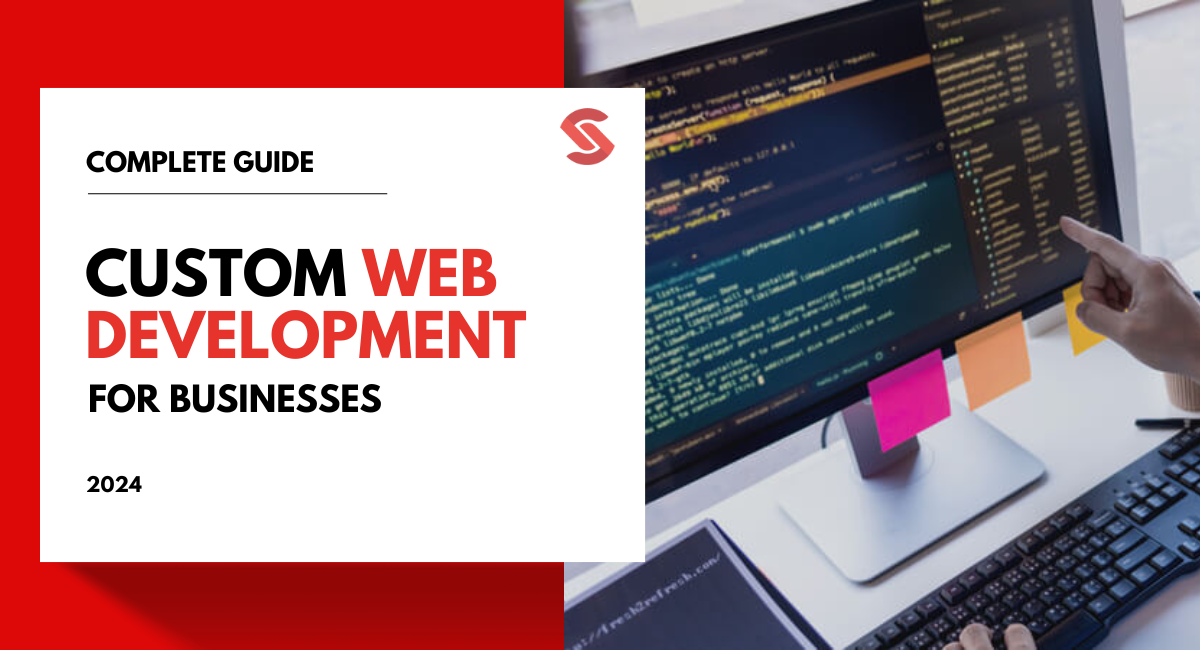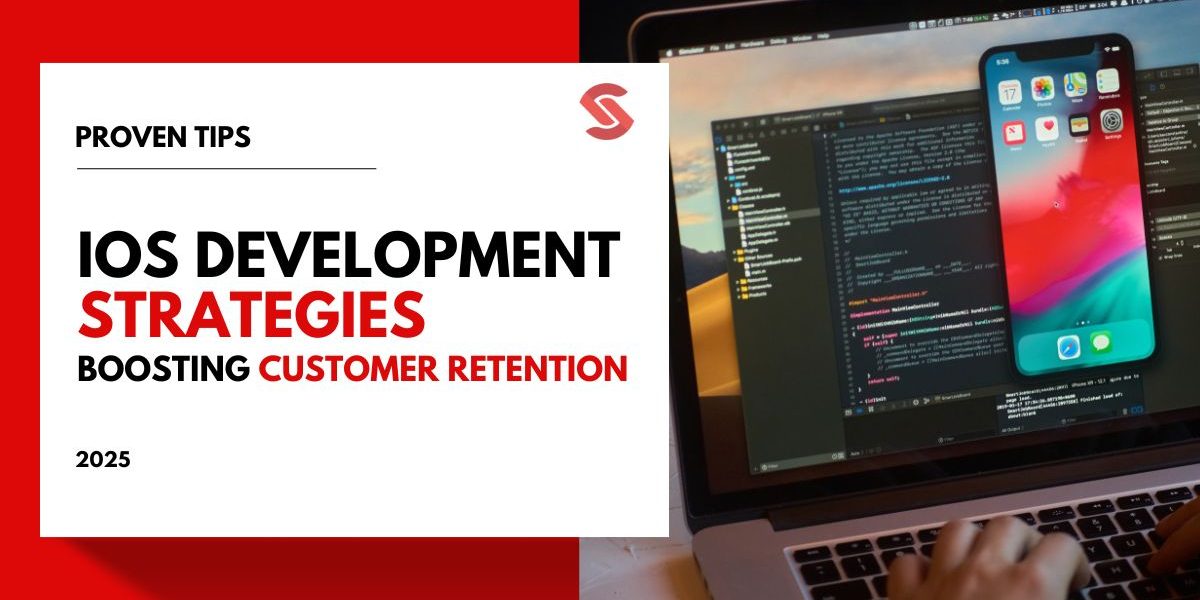The dynamics of the digital scene are changing daily, so a one-size-fits-all website often falls short of meeting unique business needs. That’s where custom web development comes in. Unlike ready-made templates, custom web development offers tailored web design and functionality that perfectly matches your business goals.
This guide will explore the advantages of custom web development, including its flexibility, scalability, and superior security. We’ll discuss the planning and development process, cost considerations, and the best practices to ensure a successful project. By the end of this guide, you’ll understand why custom web development is a smart investment for any business looking to thrive online.
What is Custom Website Development?
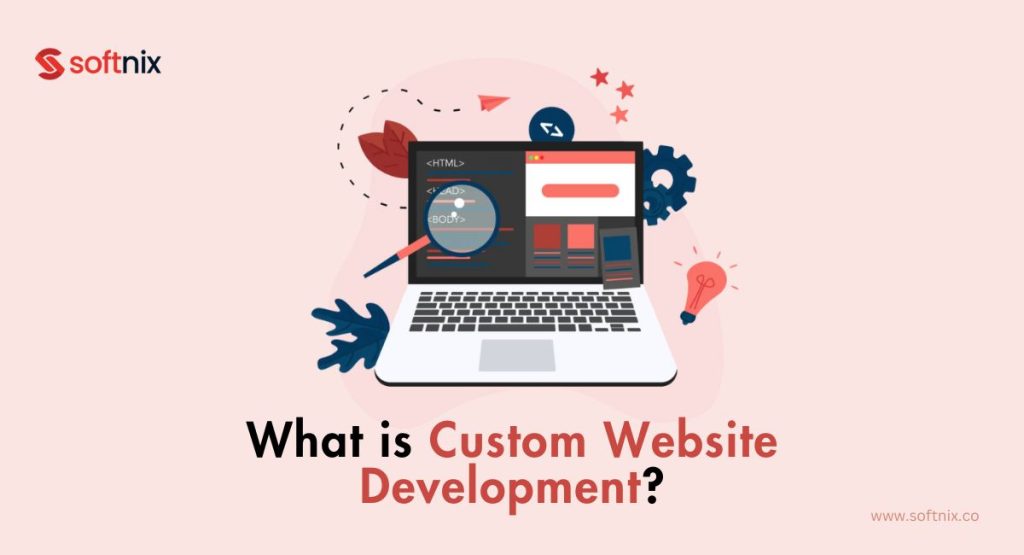
Custom website development means creating a website from scratch to meet your business needs. Unlike generic templates, custom sites offer unique features and tailored solutions. This approach ensures the site fits your brand, provides a better user experience, and includes specific functions that your business requires. Custom web development offers more flexibility, allowing for customized design and functionality. This personalized approach ensures that every aspect of the site, from design to backend, is developed to support your business goals effectively.
Why Should You Opt for Custom Website Development Solutions?
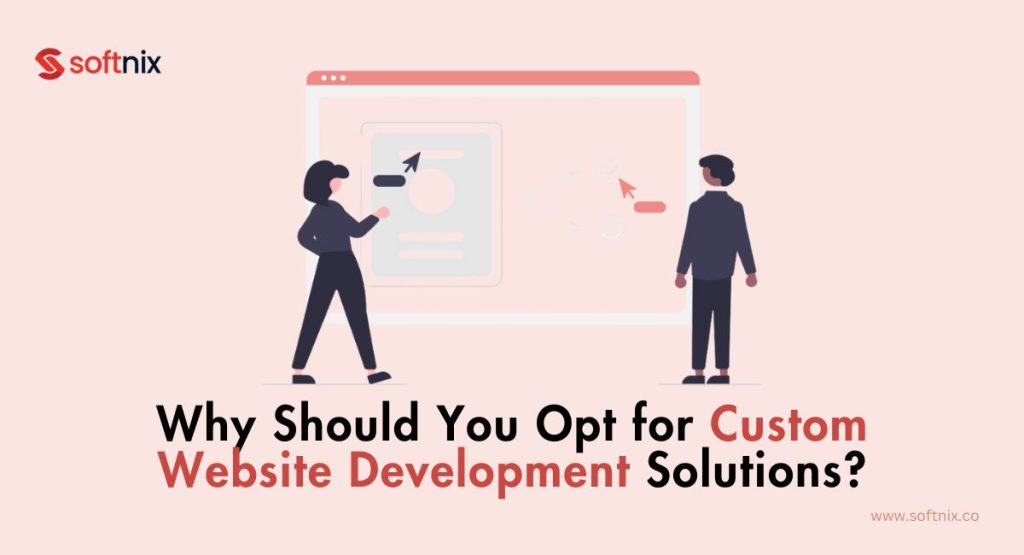
Choosing custom website development offers several strategic advantages over using pre-made templates. Custom sites are developed to meet your specific business needs, offering more than just a basic online presence. Here’s why custom development is a smart choice:
- Unique Design: Reflects your brand’s identity with distinctive, custom designs.
- Tailored Functionality: Includes features that align with your exact requirements, improving user experience.
- Scalability: Allows for easy expansion and adjustments as your business evolves.
- Better Integration: Seamlessly connects with other tools and systems for greater efficiency.
Investing in custom web development services provides strategic benefits that help your business stand out and thrive. It ensures your site is not only functional but also aligns perfectly with your business goals and objectives.
Custom Website Development vs Ready-made Website Templates
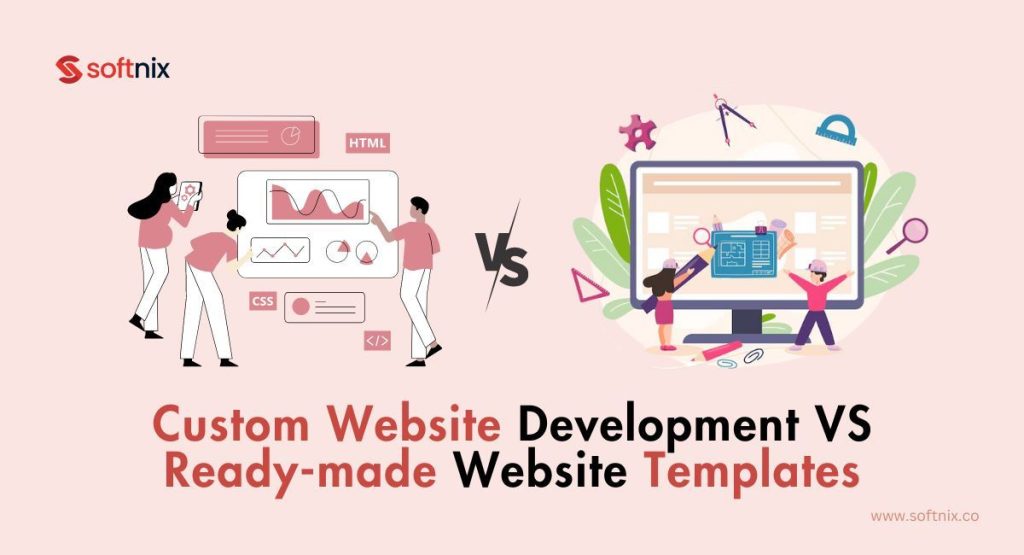
When choosing between custom websites and ready-made templates, consider their key differences. Custom websites offer a unique design and features tailored specifically to your business needs, providing a distinct online presence. While this option ensures greater flexibility and alignment with your goals, it usually involves higher costs and longer development times. Ready-made templates, however, are more affordable and quicker to implement but may lack the customization and distinctiveness needed to fully represent your brand. Templates are a practical choice for fast setup, but custom development delivers a more personalized result.
Custom Website Development
Custom website development involves creating a website tailored specifically to your business’s needs and goals. This process ensures a unique design and bespoke functionality that perfectly aligns with your brand and objectives.
Pros:
- Unique Design: Custom development offers a distinct and original design, making your website stand out from competitors and reflecting your brand’s identity.
- Tailored Features: You can incorporate specific features and functionalities that meet your business requirements, ensuring the site supports your unique processes and services.
- Flexibility: As your business grows or changes, a custom website can be easily adjusted or expanded, providing long-term adaptability and scalability.
Cons:
- Higher Cost: Developing a custom site often involves a higher initial investment compared to using pre-made templates.
- Longer Development Time: Creating a website from scratch takes more time, which can delay your launch compared to quicker template-based options.
Overall, custom website development delivers a highly personalized online presence that can significantly enhance your brand, though it requires more time and financial commitment.
Ready-made Website Templates
Ready-made website templates are pre-designed website solutions that offer a quick and cost-effective way to create a site. These templates come with built-in layouts and features, making them a popular choice for many businesses.
Pros:
- Cost-Effective: Templates are generally more affordable than custom development, making them a budget-friendly option.
- Quick Setup: With pre-designed layouts, you can have a functional website up and running much faster.
- Ease of Use: Many templates come with user-friendly tools, allowing you to customize basic elements without needing advanced technical skills.
Cons:
- Limited Customization: Templates may not fully align with your brand’s unique needs or offer the level of customization you desire.
- Generic Design: Using the same template as others can make your site look similar to many others, reducing its uniqueness.
- Potential Issues: Some templates might not be as flexible or secure as custom-built sites, potentially leading to compatibility issues.
How Can Custom Web Development Solutions Benefit Your Business?

Custom web development brings specific benefits to your business. It provides a unique website that fits your exact needs, offering features and designs tailored to your goals. If you get top-notch custom web development services it enhances user experience, supports business growth, and improves your online presence with a site that stands out from competitors. Custom solutions ensure better integration with your existing systems, flexibility for future changes, and a strong representation of your brand.
1. Tailored Functionality to Meet Specific Business Needs
Custom web development allows you to build features specifically designed for your business. This means adding unique elements that fit your exact needs, which ready-made templates might not offer. Tailored functionality ensures that your website supports your business operations efficiently, whether integrating with other tools or providing specific user functions. Custom solutions offer flexibility and adaptability, helping your site align perfectly with your business goals and processes.
2. Enhanced User Experience (UX) and User Interface (UI) Design
Custom UX/UI design focuses on creating a website that provides a superior user experience. A well-designed interface makes it easy for users to navigate, while thoughtful UX design enhances overall satisfaction. According to UX expert Jakob Nielsen, good design should make the user experience as intuitive as possible. Custom design improves usability, engagement, and satisfaction by addressing specific user needs and preferences, leading to better interaction with your site.
3. Scalability and Flexibility for Future Growth
A custom website offers scalability and flexibility, crucial for growing businesses. As your business expands, you can adjust and add new features without major overhauls. Custom development allows you to build a site that can adapt to future changes, whether increasing traffic, adding new functionalities, or integrating with new systems. This future-proof approach ensures that your website remains effective and relevant as your business evolves.
4. Competitive Advantage through Unique Features
Custom websites let you add unique features that set your business apart from competitors. Unlike generic templates, custom solutions allow you to integrate distinctive functionalities that match your specific needs. This uniqueness gives you a competitive edge, helping your business stand out and attract more customers. By differentiating your site with custom features, you improve your market position and make a lasting impression on visitors.
5. Better Integration Capabilities
Custom web development offers superior integration with your existing business systems. Tailored solutions enable seamless connections between your website and other tools, such as CRM systems or inventory management. This seamless functionality ensures that data flows smoothly across systems, boosting efficiency and productivity. Custom integration enhances overall performance and keeps your operations running smoothly, supporting business growth and adaptation.
6. Higher Security with Custom Solutions
Custom websites offer enhanced security tailored to your specific needs. Bruce Schneier, a cybersecurity expert says custom solutions can be more secure because they are designed with unique threats in mind. Custom development allows for advanced security measures, protecting your site and data from potential attacks. This level of protection ensures your business data remains safe and reduces the risk of security breaches.
7. SEO Optimized Structure
Custom web development offers significant SEO advantages, making your site more visible to search engines. A well-structured site with SEO in mind improves search rankings and attracts more visitors. Key benefits include:
- Customizable SEO Elements: Tailor meta tags, headers, and URLs to fit your content and target keywords precisely.
- Better Site Architecture: Design a logical site layout that helps search engines crawl and index your pages more efficiently.
- Enhanced Performance: Optimize loading speeds and mobile usability to meet SEO best practices and improve user experience.
An SEO-focused structure not only enhances search visibility but also helps attract and retain customers by providing them with a better browsing experience.
8. Long-Term Cost Effectiveness
Custom web development might have a higher upfront cost, but it pays off over time. Tailored websites offer long-term savings and better ROI due to their flexibility and scalability. Custom sites reduce the need for frequent updates and adjustments, minimizing ongoing costs. Investing in a custom solution often leads to greater financial efficiency, supporting your business’s growth without the recurring expenses associated with template-based sites.
How do you Plan your Custom Web Development Project?

To plan your custom web development project, first identify your business goals and user requirements. Map out the website’s features and design elements. Set a realistic timeline with key milestones. Implementing tips for effective website development can help you create a more achievable timeline. Communicate with stakeholders to align the project with your objectives. Regularly review the plan to ensure it stays on track. This careful planning helps create a website that effectively meets both business needs and user expectations.
Identifying Business Goals and Objectives
To set clear business goals for web development, start by defining what your business aims to achieve. Align these goals with your website’s purpose, whether it’s to boost sales, increase brand awareness, or provide customer support.
Tips for Identifying Business Goals:
- Define your main goals: Determine what you want to accomplish with your website, like increasing online sales or gaining more leads.
- Set measurable objectives: Make sure your goals are specific and quantifiable, such as achieving a 20% increase in site traffic within six months.
- Align with business strategy: Ensure your website goals support your overall business strategy and objectives.
- Prioritize key objectives: Focus on the most important goals that will have the greatest impact on your business success.
Outlining specific objectives, such as improving conversion rates or expanding your customer base. Regularly review and adjust these goals to keep them aligned with evolving business needs and market conditions.
Mapping User Needs and Journey
Understanding and mapping user needs involves researching how users interact with your website and what they seek. Start by identifying user pain points and preferences through surveys or analytics. Map out the user journey, which includes each step a user takes from landing on your site to completing their goal. According to UX researcher Steve Krug, “Users often need more guidance than they think they do,” emphasizing the importance of understanding their journey to improve site usability. This approach helps ensure that your website design aligns with user expectations, enhancing overall satisfaction and engagement.
Selecting the Right Development Partner
Hiring the right development partner is vital for the success of your custom web development project. A good partner will align with your business goals and understand your needs. Start by evaluating potential partners based on their experience, expertise, and past work.
Questions to Ask Before Selecting a Development Partner:
- What experience do you have with similar projects?
- Can you provide examples of your past work?
- What is your approach to project management and communication?
- How do you handle project changes and updates?
- What is your development process and timeline?
These questions help you understand the partner’s capabilities and ensure they can meet your project’s demands. A thorough evaluation of potential partners will lead to a successful collaboration, resulting in a website that effectively supports your business objectives.
What is the Custom Web Development Process?
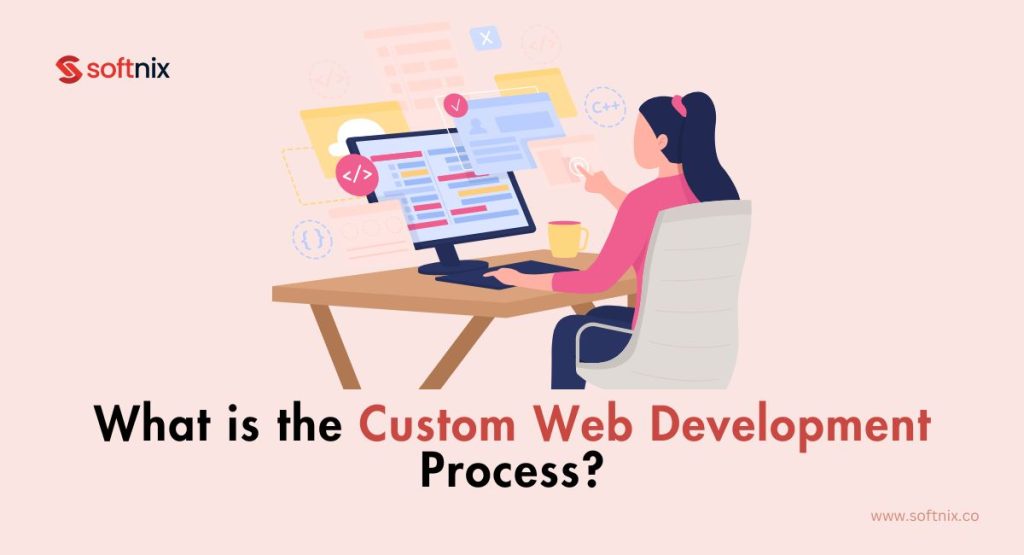
The custom web development process involves several key phases. It starts with planning, where business goals and user needs are defined. This is followed by design, Next is development, and then testing which ensures everything works as expected. Finally, the site is launched and maintained. Each phase is crucial to building a website that meets specific business requirements and user expectations.
Phase 1: Discovery and Planning
The discovery and planning phase involves initial research to understand business goals and user needs. This stage includes gathering requirements, setting project objectives, and creating a detailed project plan. By identifying key features and defining the project scope, this phase ensures that the development process aligns with business objectives and user expectations.
Phase 2: Design and User Experience
The design and UX phase focuses on creating a user-centered website layout. This involves developing wireframes, mockups, and prototypes to visualize the site structure. Attention to user experience ensures intuitive navigation and attractive design. This phase aims to create a visually appealing and user-friendly interface that meets the needs of the target audience.
Phase 3: Development and Testing
The third phase is the development and testing, which involves coding the website according to the design specifications. Developers build the site’s functionality, ensuring all features work correctly. Testing stages include quality assurance checks to identify and fix bugs. This phase ensures the site is fully functional, secure, and ready for user interaction.
Phase 4: Deployment and Maintenance
The fourth and last phase includes the deployment and maintenance phase involves launching the website and providing ongoing support. The launch process includes moving the site to a live server and conducting final checks. Ongoing maintenance ensures the site remains updated, secure, and functional. This phase includes regular updates, security patches, and user support to keep the website running smoothly.
Key Considerations for Custom Website Development Costs
When evaluating the cost of custom website development, consider several key factors. These include the complexity of features, design requirements, and integration needs. Budgeting should account for initial development, ongoing maintenance, and potential updates. Analyze the return on investment (ROI) by weighing the benefits of a tailored site against the expenses. Proper financial planning ensures a successful and cost-effective project.
Factors Influencing the Cost of Custom Web Development
Several factors influence the cost of custom web development. Understanding these elements helps in effective budgeting and financial planning. Costs can vary significantly based on specific project requirements and the complexity of the development process. Key Factors Influencing Cost:
- Project Complexity: More complex features and functionalities increase development time and cost.
- Design Requirements: Custom designs that are unique and detailed may require more resources.
- Integration Needs: Integrating with other systems or tools can add to the development cost.
- Technology Stack: The choice of technologies and platforms impacts the overall expense.
- Development Team: The expertise and location of the development team can affect pricing.
- Maintenance and Updates: Ongoing support and future updates should be factored into the budget.
Considering these factors ensures a realistic budget, helping to avoid unexpected expenses and ensuring the project stays on track. Proper planning and understanding of these elements lead to a more successful and cost-effective development process.
Budgeting for Your Project
Budgeting for your project involves careful financial planning and cost management. Start by identifying all potential expenses, including design, development, and ongoing maintenance. Allocate your budget to cover these costs, ensuring you leave room for unexpected expenses. Regularly review and adjust your budget as the project progresses to stay on track. Effective budget planning helps ensure your project is completed within financial constraints and meets your business goals.
Return on Investment (ROI) Expectations
Return on investment (ROI) expectations involve understanding the financial benefits of your web development project. Calculate ROI by comparing the project’s cost to the potential revenue it can generate. According to Forrester Research, a well-designed website can yield up to 400% ROI through improved user engagement and sales. Analyzing investment value helps determine if the project aligns with your financial goals and supports long-term business growth. Regularly assessing ROI ensures your investment delivers expected returns
How Do You Choose the Right Technologies for Custom Web Development?

Choosing the right technologies for custom web development involves evaluating your project’s needs and future goals. Select programming languages and frameworks that match your technical requirements and ensure ease of maintenance. Popular options include JavaScript frameworks like React or Angular and backend technologies like Node.js or Django. Future-proof your site by selecting tools that adapt to changing web standards and user needs.
Popular Programming Languages and Frameworks
Popular programming languages and frameworks for web development include JavaScript, Python, and Ruby. JavaScript frameworks like React and Angular are widely used for their versatility and performance. Python, with frameworks like Django and Flask, is favored for its simplicity and robust capabilities. Ruby on Rails offers a strong framework for building scalable web applications quickly and efficiently, making it a popular choice among developers.
Deciding on a Technology Stack
Deciding on a technology stack involves evaluating various criteria to ensure the best fit for your project. The right stack can significantly impact development efficiency, site performance, and future scalability.
Tips for Choosing a Technology Stack:
- Project Requirements: Assess the specific needs of your project, such as required features, expected traffic, and scalability.
- Team Expertise: Consider the skills and experience of your development team to leverage their strengths.
- Community and Support: Choose technologies with strong community support and extensive documentation for easier problem-solving.
- Future Maintenance: Ensure the chosen stack allows for easy updates and maintenance to keep the site future-proof.
Evaluating these factors helps in selecting a technology stack that aligns with your project goals, ensuring a successful and sustainable development process.
Future-Proofing Your Web Application
Ensuring your web application is future-proof involves planning for long-term adaptability and scalability. Use flexible technologies and frameworks that can evolve with changing web standards. Scalability allows your application to handle increased traffic and data without compromising performance. According to Gartner, businesses that focus on scalability achieve greater operational efficiency.
This strategic approach ensures your application remains relevant and functional over time. Long-term planning is essential for future-proofing your web application. Implement a modular architecture that allows for easy updates and integrations. Choose development tools and technologies known for their adaptability.
What Are the Best Practices in Custom Web Development?

Best practices in custom web development include ensuring strong security measures, creating responsive designs for all devices, and integrating seamlessly with other systems. Regular quality assurance checks help maintain the site’s functionality and user experience. These practices lead to successful and sustainable web development.
Ensuring Security and Compliance
Ensuring security and compliance in web development is crucial for protecting data and maintaining user trust. Implementing strong security measures helps safeguard against cyber threats and data breaches. Compliance with industry standards and regulations ensures your website meets legal requirements and builds credibility.
Tips for Ensuring Security and Compliance:
- Use HTTPS: Secure your site with SSL certificates to protect data transmission.
- Regular Updates: Keep software and plugins updated to prevent vulnerabilities.
- Data Encryption: Encrypt sensitive data both in transit and at rest.
Regularly review and update security protocols to stay ahead of potential threats. Proper compliance not only protects your business but also fosters trust with users, ensuring a safer and more reliable online experience. Adhering to these practices helps create a secure, compliant, and trustworthy website.
Importance of Mobile Responsiveness
Mobile responsiveness is essential for providing a good user experience. A mobile-friendly design ensures that your website looks and functions well on all devices. According to a report by Think with Google, 61% of users are unlikely to return to a mobile site they had trouble accessing. Responsive design improves user engagement and satisfaction by adapting to different screen sizes, making it easier for users to navigate your site and access information.
Integration with Other Business Systems
Integration with other business systems enhances the functionality and efficiency of your website. Smooth integration allows different systems to work together, improving overall business processes. Ensuring system compatibility helps create integrated solutions that boost productivity and reduce manual tasks. Effective integration leads to a more streamlined operation, benefiting both the business and its users. Integrating CRM systems, inventory management, and analytics tools can significantly enhance business efficiency and user experience.
Why Does Custom Website Development Suit Many Businesses?
Custom website development suits many businesses because it offers tailored solutions that meet specific needs. It provides flexibility, scalability, and a unique design that aligns with your brand and goals.
- Unique Features: Custom sites include specific functionalities that support your business operations.
- Brand Alignment: The design and user experience reflect your brand’s identity.
- Scalability: Easily expand and add new features as your business grows.
- Integration: Seamlessly integrate with other business systems and tools.
- SEO Optimization: Custom sites are better optimized for search engines, improving visibility.
These benefits make custom web development an ideal choice for businesses looking to stand out and effectively meet their industry-specific needs.
How Softnix Can Help With Your Custom Website Development

Softnix offers top-tier custom website development to elevate your business. Our expert team creates tailored solutions, ensuring your site meets your unique needs and stands out online. Benefit from innovative design, advanced functionality, and seamless integration. With a personalized approach, Softnix aligns your website with your business goals, driving growth and success. Trust Softnix for a propelling web solution that sets you apart from the competition.
FAQs related to Custom Web Development
What is custom web development?
Custom web development involves creating a website tailored specifically to your business needs. Unlike templates, custom websites offer unique designs, functionalities, and integrations that align with your brand and goals, ensuring a unique and effective online presence.
Why should I choose custom web development over templates?
Custom web development provides flexibility, scalability, and a unique design that templates can’t offer. It allows you to create a site that meets your specific requirements, integrates seamlessly with your business systems, and stands out from competitors.
How long does it take to develop a custom website?
The time frame for custom web development varies based on project complexity. Generally, it can take anywhere from a few weeks to several months, depending on the features, design, and functionalities required.
What factors influence the cost of custom web development?
Factors affecting the cost include project complexity, design requirements, integration needs, technology stack, and the expertise of the development team. Ongoing maintenance and future updates also contribute to the overall cost.
Can I update my custom website after it’s launched?
Yes, custom websites are built to be scalable and flexible, allowing for updates and new features as your business grows. Regular maintenance ensures your site remains secure, functional, and up-to-date.
What technologies are commonly used in custom web development?
Common technologies include JavaScript frameworks like React or Angular, backend languages like Node.js or Python, and content management systems like WordPress. The choice depends on your project’s specific needs and goals.
How do I choose the right development partner?
Look for a partner with relevant experience, a strong portfolio, effective communication skills, and a clear development process. Ask about their approach to project management, handling updates, and integration capabilities.
What is the process of custom web development?
The process includes discovery and planning, design and user experience, development and testing, and deployment and maintenance. Each phase ensures the website meets business objectives and user expectations.
How does custom web development enhance SEO?
Custom web development allows for better optimization of site structure, meta tags, headers, and URLs. This ensures your site is more search engine friendly, improving visibility and ranking, which drives more organic traffic.
Can a custom website integrate with my existing business systems?
Yes, custom websites can be designed to integrate seamlessly with your existing systems, such as CRM, ERP, or inventory management, enhancing efficiency and reducing manual work.
What are the benefits of custom web development for e-commerce?
For e-commerce, custom development offers tailored features like advanced product filters, secure payment gateways, and personalized user experiences. This helps in providing a unique shopping experience, increasing customer satisfaction and sales.
How does custom web development improve user experience (UX)?
Custom development focuses on creating intuitive, user-friendly interfaces and seamless navigation. This improves user engagement and satisfaction, making it easier for visitors to find what they need and interact with your site.
What security measures are included in custom web development?
Custom web development includes advanced security measures such as SSL certificates, data encryption, regular updates, and secure coding practices. These measures protect your site from cyber threats and data breaches.
How do I plan for custom web development?
Start by defining your business goals and user needs. Outline the project scope, set a timeline, and collaborate with stakeholders to ensure alignment. Regularly review and adjust the plan to stay on track and meet objectives.
What makes Softnix a good choice for custom web development?
Softnix offers expert custom web development services with tailored solutions to meet your business needs. Our team provides innovative design, advanced functionality, and seamless integration, ensuring your site supports your goals and drives success.

